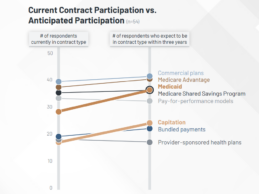A healthy, stable revenue cycle is crucial to every healthcare organization’s success. However, managing the revenue cycle takes experienced coders, complete documentation, and timely resolution of denials.
Administrative processes account for about 30% of U.S. healthcare costs, which means that all areas of a patient encounter, from check-in to billing and claims, are potential targets to obtain greater efficiency.
In the past 20 years or so, computer-assisted coding (CAC) has become
Read More
Predictive Analytics in Healthcare | Health IT | Digital Health | Patient Care Solutions | News, Insights, Analysis - HIT Consultant
Enhancing Physical Therapy With Artificial Intelligence
In 2014, Stephen Hawking cautioned that “the development of full artificial intelligence could spell the end of the human race….It would take off on its own and re-design itself at an ever-increasing rate..”
Artificial intelligence (AI) has advanced rapidly in recent years, with its impressive power and capacity to change so many areas of human life. It continues to become more embedded in the lives of average consumers. While AI might not yet be the end of humanity as we know it, we’re
Read More
Exec Hires: Former WebMD Exec Joins ODAIA as New Chief Commercial Officer
What You Should Know:
- ODAIA, the company empowering pharma’s next generation of engagement with healthcare professionals through predictive analytics announces the appointment of Dr. Eric Trépanier (Pharm.D, CFA) as its new Chief Commercial Officer.
- As Chief Commerical Officer, Trépanier will drive sales of ODAIA’s MAPTUAL Sphere and MAPTUAL Field products, which aim to expand and deepen relationships between physicians and the commercial teams and sales reps at pharma
Read More
Unlock the Full Potential of Inpatient Bed Capacity with AI
Every day, hospital staff do the best they can to navigate the daily chaos of bed management by making educated guesses as to what is going to happen over the course of the day. Relying on team huddles throughout the day, staff pore over Excel or paper spreadsheets to predict how many beds will open up and when. They try to estimate demand for those beds by the time of day, unsure when to deploy “surge capacity.” On some days, this method works out well. However, more often than not, the staff’s
Read More
4 Roadblocks That Are Hindering The Promise of Predictive Analytics
COVID-19 will likely impact and strain healthcare systems for many years to come — possibly even forever. As its attention wanes, we need technology to step in and tell us when and how to act next. What if there was a way to predict the next COVID-19 surge months before it affected operations? How many beds will be available? PPE? Where will you need to allocate additional resources and staff? What other seasonal uptick of disease will it align with? Will our revenue take a
Read More
4 Roadblocks Hindering The Promise of Predictive Analytics
COVID-19 will likely impact and strain healthcare systems for many years to come — possibly even forever. As its attention wanes, we need technology to step in and tell us when and how to act next. What if there was a way to predict the next COVID-19 surge months before it affected operations? How many beds will be available? PPE? Where will you need to allocate additional resources and staff? What other seasonal uptick of disease will it align with? Will our revenue take a
Read More
KLAS: State of Value-Based Care Reimbursement in 2022 Trends
What You Should Know:
- Value-based care (VBC) has been established as a priority among healthcare organizations and payers as participants have gained more experience in managing their quality metrics and contracts, ultimately realizing returns on their investments.
- For their latest report, Value-Based Care Reimbursement 2022, KLAS talked to 54 healthcare executives—including CEOs, CFOs, CIOs, CMIOs, COOs, VPs and directors of population health, and VPs of analytics—to gauge how
Read More
AGS Health Launches AI-Powered Revenue Cycle Platform
What You Should Know:
- AGS Health, a revenue cycle management (RCM) solutions provider and strategic growth partner to some of the largest healthcare systems in the U.S., announces the launch of the AGS AI Platform, a connected solution that blends artificial intelligence (AI) and automation with award-winning human-in-the-loop services and expert support to maximize revenue cycle performance.
- The platform allows healthcare organizations to gain enhanced visibility into day-to-day
Read More
AI-Powered Pop Health and SDOH – The Good, The Bad and The Best Practices
Artificial intelligence (AI) has emerged as a powerful tool for making population health analytics more accurate and interventions more effective. Not all AI-powered pop health tools are created equal, and while many still exhibit different types of bias that limit their ability to accurately identify issues affecting certain populations, we have learned a lot about the sources of bias in AI and how to eliminate them. AI shortcomings aside, pop health analytics have advanced to the point that we
Read More
Connected Devices Selection: Considerations for A Digital-First Approach to Data Collection
In recent years, digital health technologies (DHTs) have significantly changed the way we collect data within clinical trials. This is partially due to the overarching industry shift toward patient-centricity, but in some cases, it is also due to the commercial availability of powerful technology solutions not previously feasible for use in medical devices. In the past, nearly all patient data have traditionally been acquired by purpose-built machines manufactured by relatively small-scale
Read More










